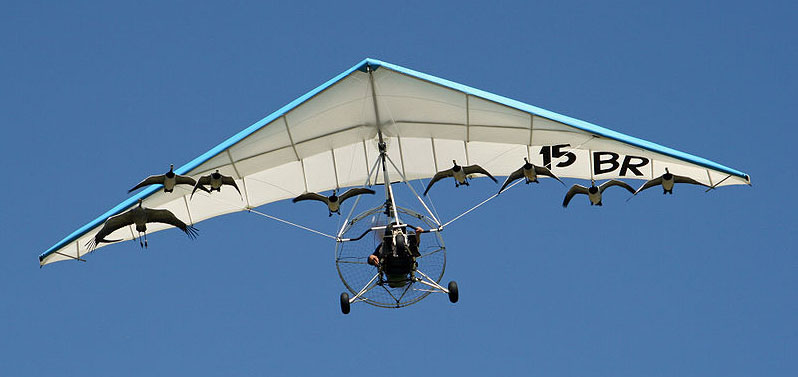Example 2:
 (Photo: Wikipedia - Christian Moullec flying with geese in Dahlem, Germany)
(Photo: Wikipedia - Christian Moullec flying with geese in Dahlem, Germany)
The Italian hang-glider pilot Angelo d'Arrigo noted that the flight of a
non-motorised hang-glider is very
similar to the flight patterns of migratory birds: both use updrafts of hot
air (thermal currents) to gain altitude which then permits soaring flight
over distance.
Birds which are hatched in captivity have no mentor birds to teach them their
traditional migratory routes. D'Arrigo had one solution to this problem. The
chicks hatched under the wing of his glider, and imprinted on him.
Subsequently, he taught the fledglings to fly and to hunt. The young birds
followed him not only on the ground (imprinting - as with Lorenz) but also
in the air as
he took the path of various migratory routes. He flew across the Sahara and
over the Mediterranean Sea to Sicily with eagles, from Siberia to Iran
(5,500 km) with a flock of Siberian cranes, and over Mount Everest with
Nepalese eagles. In 2006, he worked with a condor in South America. (Wikipedia) -
This seems to illustrate that learned skills can be passed from one generation to
the next.
Question 1: What innate skills are required for this learning process?
Question 2: How are skills learned, i.e. how is the information generated that can produce skilled action?
Question 3: How are learned skills integrated with innate skills, and how to they differ?
Short answer 1: Imprinting and mimicry
Short answer 2: Imprinting and mimicry generate an action pattern which is then abstracted into the 'inner language' and stored.
Short answer 3: Learned skills that are represented in the 'inner language', i.e. that call on basic innate skills, should be similar to higher-level innate skills. Adding to the basic skill-set not represented in the 'inner language' likely requires a different process.